Asking clients for testimonials to add to your website is a low-cost tactic that increases your credibility, conversion rates, and sales—among other benefits.
We’ll cover how to get testimonials to add to your website, how to use them effectively in your marketing, and much more.
What is a testimonial?
Testimonials are endorsements from real people who have used your products or services and loved them enough to share with friends, relatives, colleagues, and strangers on the Internet.
Testimonials are social proof. When used effectively, they show that you are credible and convince potential customers that they should buy your product or service.
Types of testimonials
A testimonial can take many forms from quotes on your website to customer videos shared on social media. Here are different types of testimonials you can leverage on your website and marketing.
- Customer quotes
- Images
- Case studies and success stories
- Videos
- Customer interviews
- User-generated content
- Star ratings
- Blog post reviews
1. Customer quotes
One of the most common types of testimonials is a quote. These are usually one to two sentences of text that praise your business. They may explain why that customer loved your course and how your course improved their life.
Sometimes, they may also include the customer’s name, job title, or industry.
2. Images
Often, businesses pair quotes with headshots of customers or images of them using their product. Testimonials with photos put a face to text and a name, humanizing it. If you add images to your testimonials, it can make them more relatable and more powerful.
3. Case studies and success stories
Sometimes, a few sentences of text don’t do your business justice. In this case, try a case study, also called a customer success story.
These are in-depth testimonials that typically follow a challenge, solution, and results format. Typically, they are long-form blog posts or short videos, but they can be a combination of both. When creating customer stories, focus on how your course transformed a student’s life. What was their life like before compared to after?
4. Videos
Did you know that 84% of people say they’ve been convinced to buy a product or service after watching a video? Video is a powerful medium to share testimonials on your website, social media, and other marketing.
5. Customer interviews
Customer interviews are similar to success stories, except they are in the format of a Q&A. You can record a video and add a transcript to publish on your site’s blog. If a customer agrees to do an interview, create a list of three to five questions ahead of time. You can also share it with them before so that they feel prepared—but not rehearsed—when you record their responses.
6. User-generated content
Technically, all testimonials are “generated” by users. After all, testimonials are your customers sharing their experiences. However, the difference between a user-generated testimonial and others is that a customer shares it instead of a company.
Because it is shared by a person directly, it can be even more powerful than a testimonial that you share on your site. A lot of user-generated testimonials are published on social media.
Sometimes, it happens without you even asking. So, you’ll want to set up a Google Alert for you or your business’ name and check your social media mentions so that you don’t miss it.
7. Star ratings
Star ratings are most often associated with reviews, but they are a type of testimonial. They’re also convenient to your customer since they don’t take as much time or effort as writing an entire review. However, they provide little information, and as a result, aren’t as well-trusted as other, more in-depth reviews.
8. Blog post reviews
Customers can go into detail about their experiences with a blog post. For many software and ecommerce companies, it is common for customers to write up full articles that highlight product features and benefits. They may even show others how they could use your product or service in their lives.
You can publish blog post reviews on your own website, but they may be more beneficial when posted on your customer’s website. For instance, if the customer is an influencer or has significant traffic to their blog, they could increase your overall reach and attract new customers. Of course, if that’s the case, you’ll want to link to it on your website or leverage it in other marketing.
Why testimonials matter
Testimonials have been proven to have a tremendous ROI, be cheap, scalable, and effective at lead generation and conversion. However, don’t take our word for it, have a look at what the statistics say:
- More than 99.9% of consumers read reviews and testimonials to decide whether or not to make a purchase (PowerReviews)
- 72% of customers say positive reviews and testimonials impact how much they trust a brand (Big Commerce)
- Another 72% say they only make a purchase after seeing a positive review (Brighton SEO)
- On average, a testimonial placed on a sales page increases conversions by 34% (IMPACT)
- More reviews can create higher conversion rates – 50 or more reviews per product can increase conversion rates by 4.6% (Econsultancy)
If you leverage your testimonials effectively, you can create brand ambassadors who spread the word about your educational offerings far and wide. In addition, testimonials are cost-effective. You don’t pay for them, but they are instrumental in proving your course’s value and attracting new clients.
How to get testimonials to add to your website
Once you’ve launched your course and worked with a few clients, it’s the perfect time to get testimonials to add to your website. But, how do you do that?
Here are some tips that can help you get more, high-quality testimonials to add to your website and marketing.
1. Ask at the right time
Most of your customers appreciate the effort you put into your online classes and have seen measurable improvement from them. However, they may not share their experiences unless you ask them.
You’ll also increase your chances of getting testimonials to add to your website if you ask at the right time. Of course, you’ll want to ask for feedback from students right after completing your course so it is fresh in their minds.
However, you don’t have to wait until someone has completed an entire course to get feedback. Although, it helps to see how much they have learned and what has changed before starting and after completing it.
Sometimes, a large course may take several months to complete, so you might want to break it up into phases. If it’s your first course, getting testimonials and reviews sooner can increase enrollment for the next cohort.
In this case, you can reach out once students have made it to a certain milestone. Ask about the specific sections they’ve completed so far, and then circle back when they’ve finished it in its entirety.
Feedback from customers is not just useful for testimonials. It can go a long way in helping you iterate and improve upon your course, so you don’t—and sometimes shouldn’t—wait until the end to ask.
2. Make it easy to gather feedback
To get as many testimonials as possible, it is critical that you make it as easy as possible for customers to share their experiences.
There are a few ways that you can make it quick and easy for customers to provide testimonials. One of the most popular is to send out a short customer survey by email. You can also add a form to your website for customers to submit feedback at any time.
Besides the delivery, you should consider what type of questions to ask in your survey. That said, you can go with one to five questions. Add fields for yes or no or short answer responses. The more questions you add, the fewer responses you should expect.
Paying for positive reviews is illegal and unethical, but you can and should encourage customers to share their honest opinions. If you find that not many are responding, you can encourage responses by offering a discount or giveaway for completing the survey, regardless of a negative or positive response.
3. Set automatic reminders
Asking all your customers to provide a testimonial takes time and coordination. Luckily, you can automate most of the process.
For example, set email triggers to automatically ask for a testimonial when someone completes a percent of your course. You can also schedule emails to go out after a certain number of weeks or months from their initial purchase.
By automating requests, you can save time and ask for feedback when it is most convenient or valuable. However, make sure that you aren’t overdoing it. You don’t want to ask so often that you annoy customers, so keep it to a minimum.
4. Always ask for permission
You should always get consent from your customers before sharing their customer stories. If someone publishes their opinion on social media or a Google review, then it’s up to them. But, for example, if you want to republish a student’s Instagram Reel talking about your course to use in paid ads or elsewhere, then you need written permission.
It’s a standard business practice, and your customers will appreciate that you asked.
You can ask for permission by sending your customer an email using pre-made permission templates you can find online.
Besides emails, other approaches that you can take to ask for permission from your previous course students are:
- Direct message them through the social media platform they used to share their story
- Embed a consent clause (or pop-up screen) in your testimonials sales page
- Send your customer an SMS requesting permission
- Request a complete name and credentials that you can include in the testimonial to increase its credibility
Tips for displaying testimonials
Once you’ve built a process for getting testimonials to add to your website and marketing, the next step is to put them to use.
A good review is a terrible thing to waste, especially when you’re trying to address prospect hesitations and grow your audience.
How do you take full advantage of your student testimonials? Here are some tips on how to add testimonials to your site and marketing effectively.
1. Leverage social proof across channels
Testimonials are a type of social proof, and they are incredibly valuable. Look at the websites of successful brands, and you’ll find examples of social proof. From customer product reviews to press features, it is one of the best ways to attract customers.
Psychologist and author Robert Cialdini coined the term “social proof” as far back as 1984, with his book Influence: Science and Practice. According to Cialdini, social proof is when we look at the behaviors of others to influence our own actions and behaviors. When we are uncertain about a decision we emulate others, whether that’s a friend, celebrity, or someone else. The more we see others using a product or service, the more we view that as something we should also use.
For example, a prospective student is likely to enroll in your course with the knowledge that you’ve trained a thousand students before.
The opposite is true. If you’ve never trained a student, fewer students will be willing to take the risk of being first. Fortunately, there are several ways to leverage social proof when promoting your course, including:
- Create a badge or official certification your client can display on platforms such as LinkedIn
- Display client quotes and testimonials on your homepage, course, and sales pages
- Include the number of students you’ve trained on your sales page with a headline like “1,000 marketers trained”
- Have an alumni list of successful individuals that have passed your online course
2. Create a dedicated landing page
Including a testimonial landing page in your course sales funnel is an excellent strategy for converting prospective students.
For example, if you run an email marketing campaign, you can send your email subscribers directly to your landing page as social proof. Popular design tool Canva and project management software Basecamp both have millions of users. To make the most of customer testimonials, the two companies house them on dedicated landing pages.

Even though Basecamp has a dedicated landing page for testimonials, it still features them elsewhere on its site. If you look at the homepage, you’ll see reviews there too, above the fold.
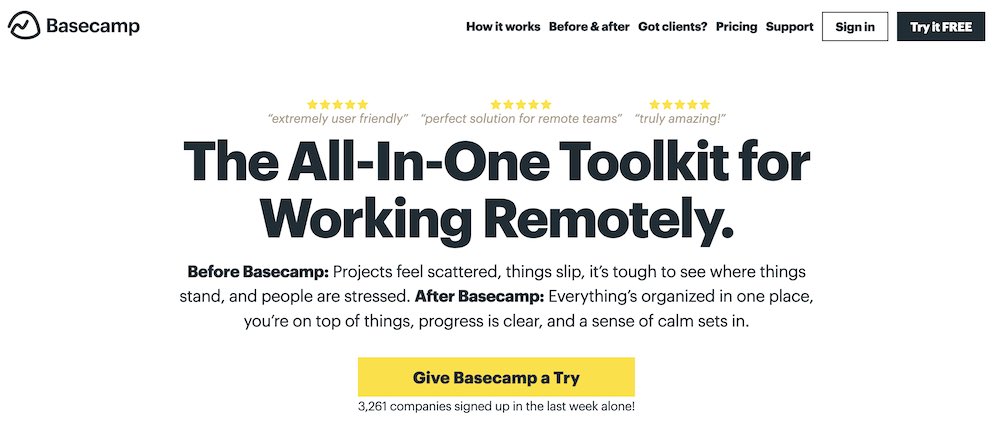
When you have a lot of reviews and don’t want to miss out on the benefits they bring, you might want a separate testimonial page. Then, strategically place the best snippets in other places on your site and marketing.
3. Combine types of testimonials
You are not stuck with using one type of testimonial. It’s actually more beneficial if you combine content types. For example, adding a video to a blog post shows a person you’re product in action versus telling them about it.
According to HubSpot, when consuming brand content, 53% of people prefer watching videos. Using visuals like photos and videos also adds another layer of credibility to your testimonials. More people will perceive a video of a person endorsing your product as authentic compared to some text on a page.
4. Repurpose and reshare on social media
Testimonials and social media go hand-in-hand. You can post positive testimonials on your website and republish them on social media pages. When you repurpose testimonial content, you maximize the number of people you reach, or in other words, potential customers.
On top of that, you can leverage certain features on social media platforms by:
- Uploading video testimonials from your clients on Instagram Stories and Reels
- Posting quote images or short video testimonials on Facebook
- Adding video testimonials or showcasing parts of a customer’s review on TikTok using its Stitch or Duet features
Many discover brands on social media, so leveraging it for your testimonials can help you raise awareness.
5. Reward loyalty
A brand ambassador is someone who spreads positive word-of-mouth about your brand through, primarily, testimonials and user reviews. Brand ambassadors can be former or current customers or clients.
You might consider turning your current students and alumni into brand ambassadors by offering rewards programs. Internal rewards programs, such as our student referral program, can do wonders for boosting your course’s try-out rate and improving your online reputation.
Examples of website testimonials
It is easy to get inspiration for displaying testimonials—brands and course creators use them all the time. However, some do it better than others. Here are a few of our favorite testimonial examples.
1. Ahrefs
Ahrefs is a content marketing company that helps brands improve their search engine optimization, customer engagement, and conversion marketing.
If you look at the Ahrefs homepage, it’s like a masterclass in how to present social proof effectively. For one, they display exactly how many Ahrefs accounts have been created.
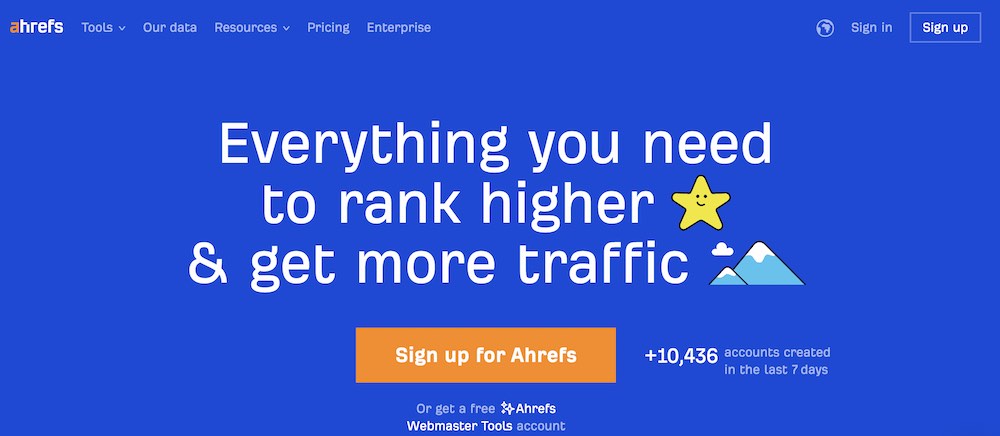
As you scroll down, you’ll see logos of highly recognizable brands that use Ahrefs. Presumably, marketers at these companies gave Ahrefs permission to feature these, so it’s like a badge of approval.

Lastly, Ahrefs has this testimonial section that speaks to each of its different target audiences—bloggers, agencies, content marketers, and so on. It uses quotes, images, and a clean, fun design.

2. Fabletics
Fabletics is another example of a brand that leverages testimonials on its website. If you aren’t familiar with it, Fabletics sells activewear, often partnering with influencers and celebrities like Lizzo to create and promote collections.
On the Fabletics homepage, you’ll notice that the brand has synced its Instagram to its site. Social media is a form of social proof. When customers and influencers, post photos of themselves wearing Fabletics it’s a sign of approval. Plus, people are more likely to be interested in making a clothing purchase when they can see people that look like them wearing it.
Fabletics also uses numbers and testimonials on its “how it works” page. To build credibility, it highlights that there are over two million members, and includes a customer’s photo with a quote testimonial.
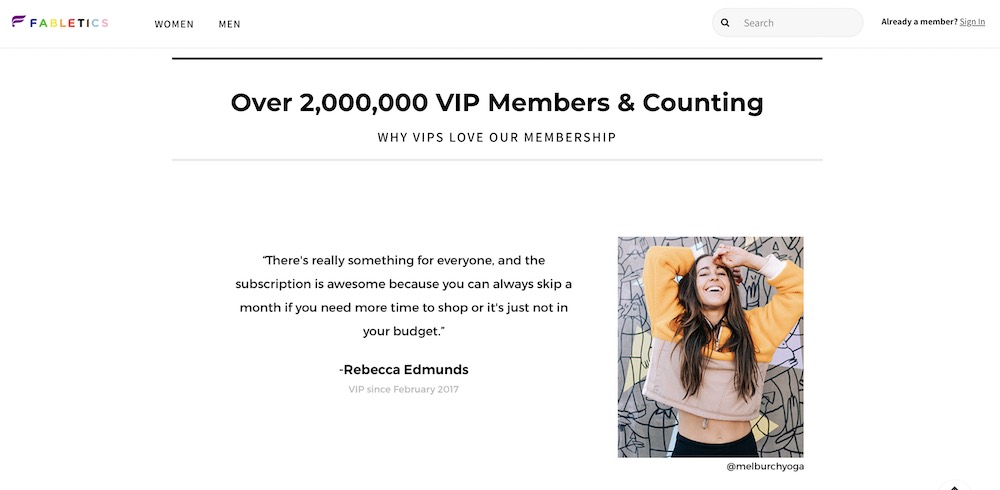
3. Codeacademy
Codeacademy is an online coding bootcamp. It combines multiple types of testimonials—customer success stories, images, and video—on its site and marketing effectively. For example, on the homepage, the headline “Stories from real people” features many customers’ images and their stories.
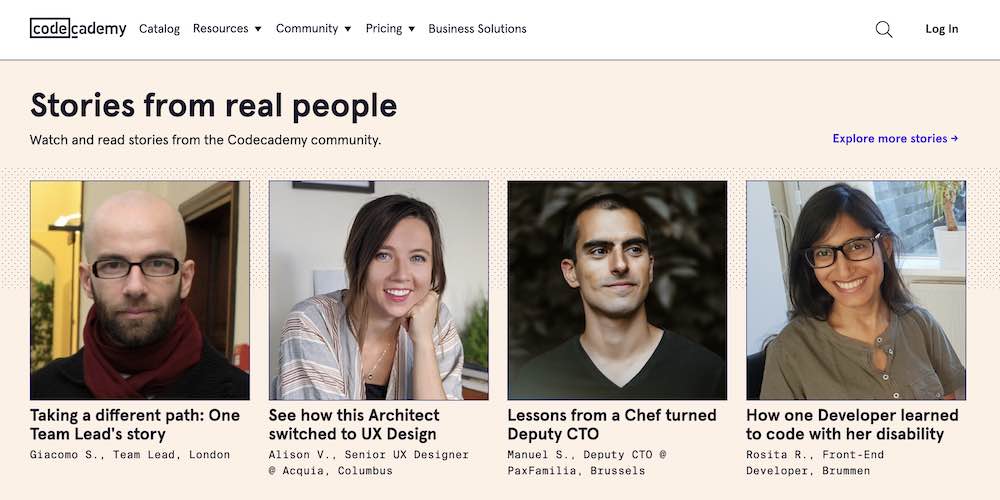
When you click on the section, you can view an entire page dedicated to a range of customer stories.

You can watch video testimonials and read blog posts and interviews. There are even quote blocks throughout the page.

Overall, it is a perfect example of how you can combine multiple types of content to display powerful social proof.
4. Self Publishing Formula
Now that we’ve looked at a few examples of how brands use testimonials, let’s take a look at courses. There are many Teachable course creators that leverage testimonials effectively. Mark Dawson is one of the best. Mark’s website has a range of resources for authors to market their books.
For example, if we go to the course sales page for “advertising for authors”, you’ll see social proof immediately. An author that took the course shares real, measurable results—“I went from $400 months to $10,000”.
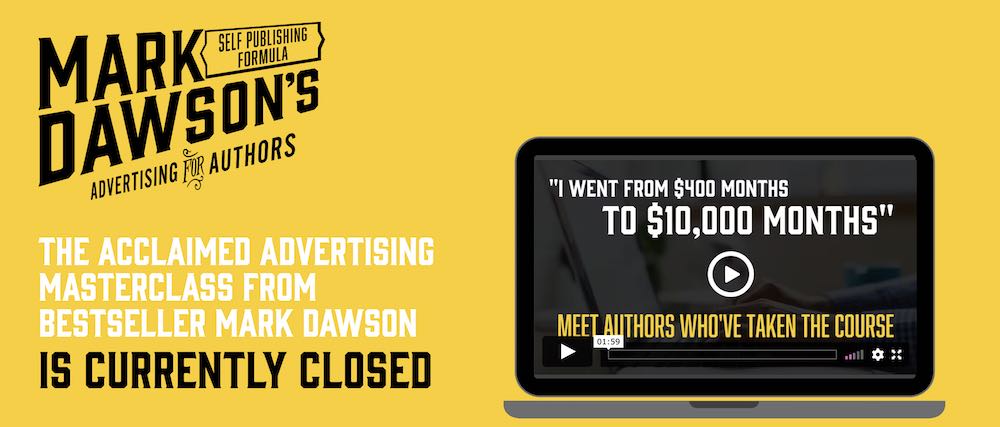
If you click on the play button, you’ll see a video testimonial that showcases that client’s story. In addition, if you scroll down, you can see a section with more client testimonials. This time, there are headshots of clients and quotes.

The customer quotes show clients what they can expect from the course, based on what others have accomplished.
5. Ui:dev
Ui:dev, a coding course focusing on Javascript, is another Teachable creator that has mastered the art of testimonials. On the homepage, you can see a feed of reviews that combines star ratings with customer feedback. It updates automatically, so they never miss a review.

In addition, each individual course sales page has reviews. Similar to product reviews for ecommerce websites, customers want to read specific experiences and feedback for each course.

Testimonials add a wealth of value to your site and course pages, with little cost to you. Once you learn how to reach out to customers to get testimonials to add to your website, it’s all about presentation. How will you use testimonials on your website, social media, and marketing to attract more customers?
These tips and examples will give you inspiration, but ultimately, you have to get started with a course first. If you haven’t created a course yet, you can test out Teachable for free today. If you aren’t sure where to start or which plan you need, you can get personalized advice from the Teachable team by answering a quick survey.
Join more than 150,000 creators who use Teachable to make a real impact and earn a real income.


%201%20(1)%20(1).png)

.png)
.png)


